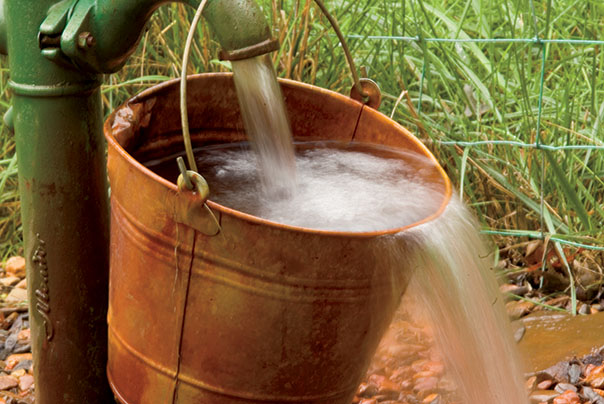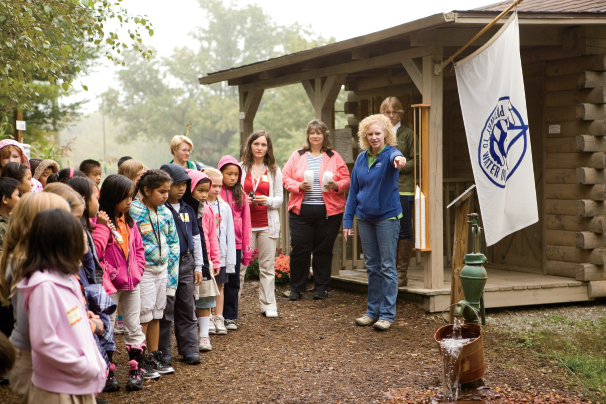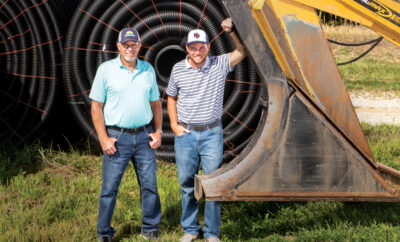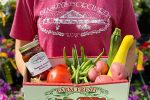Pathway to Water Quality Exhibit at State Fairgrounds Promotes Conservation

Have you ever stopped to think about the significance of soil? DeeDee Sigler certainly has.
“Soil is an important ingredient in our everyday life,” says Sigler, communications manager for the Indiana Association of Soil and Water Conservation Districts and co-chair of the Pathway to Water Quality Steering Committee.
“We sleep in a building that sits on soil,” she notes. “We wear clothes that were created based on soil. Our food comes from the soil. Our medicines are made from things grown in the soil. Our water is filtered through the soil. ”
That connection between soil and water is the star of the Pathway to Water Quality exhibit, managed by the eight-member Indiana Conservation Partnership. At its Indiana State Fairgrounds location, friendly volunteers direct visitors through a winding walkway lined with educational exhibits and hands-on activities that teach how to protect our soil and water resources.
A Parking Lot Paradise
In 1993, members of the Indiana Conservation Partnership created the 1.5-acre exhibit out of a parking lot on the northeast side of the fairgrounds in Indianapolis.
“Having seen the need to showcase conservation practices, Pathway went from barren ground to a very park-like setting to demonstrate how a model watershed works,” Sigler says. “We all live in a watershed, an area or region drained by a river, lake or stream. Water ‘shedding’ off the land impacts our soil and water quality. Our water in Indiana is shed ultimately through our rivers into the Mississippi River, the Gulf of Mexico, and into the Atlantic and Pacific oceans. We want the public, both nonagriculture and agriculture-based, to understand how they can implement best management practices on their own land.”
Pathway to Water Quality features several distinct areas to view and learn from, including conservation tips, both for at home and when visiting natural areas such as woodlands and wetlands.
“Most people going through the exhibit are urban and suburban,” Sigler says, “so the range of hands-on and interactive activities and take-home ideas for adults and children can go a long way to helping them understand soil and water health.”
A yard-like setting displays native plants that, once established, require less watering and fertilizer. The exhibit also showcases rain barrels sitting under downspouts to collect and store rainwater for watering plants and gardens.
“Most of our grandparents and great-grandparents were true conservationists,” Sigler says. “They captured rain in barrels outside their houses out of necessity to water their gardens and flowers. Now, city dwellers can reduce water costs by using such barrels.”
A newer outdoor favorite, rain gardens use plants to absorb and filter rainwater. They prevent pollutants from washing into your lawn, streets or storm drains.
“Rain gardens filter out impurities, look beautiful in yards and provide habitat for wildlife,” Sigler explains.
Gardeners and farmers can also discover how to use compost and cover crops for their own garden plots. Cover crops improve soil health for both landscaping and farm ground. Meanwhile, backyard conservationists can learn about pond wetlands, native tree plantings, mulching and how to create wildlife habitat. Even corporate developers or city government officials can get an applicable lesson on concrete.
“Pervious concrete, which allows water to filter through instead of run off, is a great practice in cities and towns,” Sigler says. “Parking lots can partially use pervious strips for engineered water drainage instead of all asphalt or concrete.”

A State Fair Oasis
When the draining summer heat makes you look for a welcoming oasis from the Indiana State Fair, head for the lush, cool green space of the Pathway to Water Quality. Its primary season for visitors is the 17-day event in August.
What’s more, Pathway will celebrate its 20th anniversary at the 2013 Indiana State Fair.
“We are expanding available information for home gardeners and farmers,” Sigler says. “We hope to restore the front wetland pond area, along with seeking funds and sponsors for the project.”
More than 220 volunteers help out at Pathway during the fair. Visitors with smartphones can also scan codes to receive links for more exhibit information or to get help answering questions. During the fair, the exhibit also hosts demonstrations on soil health, water quality and invasive plants.
“If we share with people at the fair on how to start a rain barrel, or someone starts using cover crops to enhance soil health,” Sigler says, “we are making a difference in the watershed and have continued to grow our pathway to water quality.”
Pathway Partners
The Indiana Conservation Partnership, which manages the Pathway to Water Quality, includes the following:
- Indiana Association of Soil and Water Conservation Districts and the 92 individual districts
- Indiana Department of Environmental Management
- Indiana Department of Natural Resources
- Indiana State Department of Agriculture, Division of Soil Conservation
- Purdue University’s Cooperative Extension Service
- State Soil Conservation Board
- U.S. Department of Agriculture Farm Service Agency
- USDA’s Natural Resources Conservation Service
Learn more about the exhibit, including what you can do to improve water quality at home, at www.pathwaytowaterquality.org.













 My Indiana Home is produced for Indiana Farm Bureau members. Our mission is to connect you with the food you eat, the Indiana farmers who grow it and a rural lifestyle that is uniquely Hoosier.
My Indiana Home is produced for Indiana Farm Bureau members. Our mission is to connect you with the food you eat, the Indiana farmers who grow it and a rural lifestyle that is uniquely Hoosier.
Leave a Comment